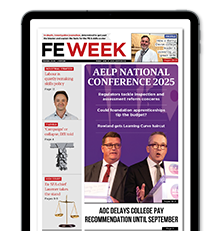In my previous life as a college tutor, January was always the month of the annual student awards evening. Each year we would dutifully send in our list of worthy candidates. The brief was fairly succinct: nominees must have been enthusiastic learners who attended fully and punctiliously.
They must of course have produced work of high merit. Finally, and perhaps with one eye on the PR benefits, we were also encouraged to identify those who had overcome ‘significant personal obstacles’ in order to attain their qualification.
One year, a student of mine – I’ll call her ‘Irene’ – scooped the student of the year award. She fulfilled all the prerequisites. She was in her mid-sixties and undertaking her first recognised qualification in some fifty years. She had left school with no qualifications. Her work was genuinely exceptional.
However, Irene was a distance learning student and I clearly remember that this didn’t sit well with some of my colleagues. For the academic purists, distance learning wasn’t ‘real’ teaching or learning.
That unless the bestower of education was at the front of their classroom imparting their wisdom, something substandard was going on.
Although some of the purists may still hold that view, there is little doubt that attitudes have changed and distance learning (also commonly referred to as ‘remote’ or ‘distributed’ learning) has established itself as a credible alternative to traditional classroom delivery for some types of learners, qualifications and sectors.
In the last two decades providers have embraced established and emerging technologies to turn distance learning into an extremely valuable tool, bringing benefits to both individuals and employers, as well as to the providers themselves”
One reason for this is that education providers have sharpened up their act in terms of their distance learning provision. Sure there are still stories of overseas ‘degree mills’ conferring bogus distance learning ‘qualifications’ on those willing and desperate enough to pay.
However, in the last two decades providers have embraced established and emerging technologies to turn distance learning into an extremely valuable tool, bringing benefits to both individuals and employers, as well as to the providers themselves.
What are the benefits to the individual? Well, perhaps the most obvious is flexibility. Distance learning gives the learner the opportunity to learn anytime, anywhere.
This is ideal for those that are in employment or have to fit learning around other commitments. Learners are not beholden to a college timetable or set enrolment dates.
For example, online learning usually allows learners to save work and log back into where they left off and podcast lessons can be downloaded and listened to on the go. Mobile learning, or ‘mlearning’, done well, may take distance learning to another level.
Some providers are already using smartphone applications to enable their students to complete quizzes and assessments via their phones or other handheld devices.
Employers are also becoming increasingly switched on to distance learning. Understandably, organisations that are operating with a lean workforce are reluctant to release staff en bloc for training.
However, distance learning allows companies in tandem with their training providers to build elearning activities, for example, into quieter work periods.
Better still, if the individual can see the personal benefits of undertaking such training, many are prepared to complete their learning at home.
Finally, what are the benefits to the providers themselves? In an age of economic austerity, distance learning can be an extremely cost-effective option. Take the 100 hours learning ‘away from the workstation’ obligation under apprenticeships.
This can be delivered via distance learning and many providers are now using elearning packages to deliver this. By reducing travelling times and the number of workshops, these allow assessors to deliver to more learners and to cover a much wider geographical area.
You only have to look to some of the examples from North America and Australia to see how distance learning, in particular elearning, has enabled providers to penetrate the hitherto impenetrable.
Distance learning has still to lose some of its blemishes. But, like classroom-based delivery, if those involved in the delivery are passionate and there is a scrutinous eye on quality, surely innovative distance learning deserves a seat at the same table as the more traditional methods of teaching.
By Lee Brooks









Your thoughts